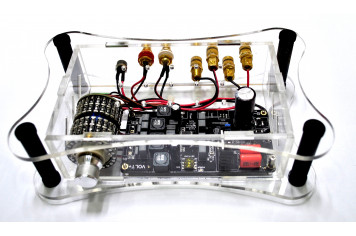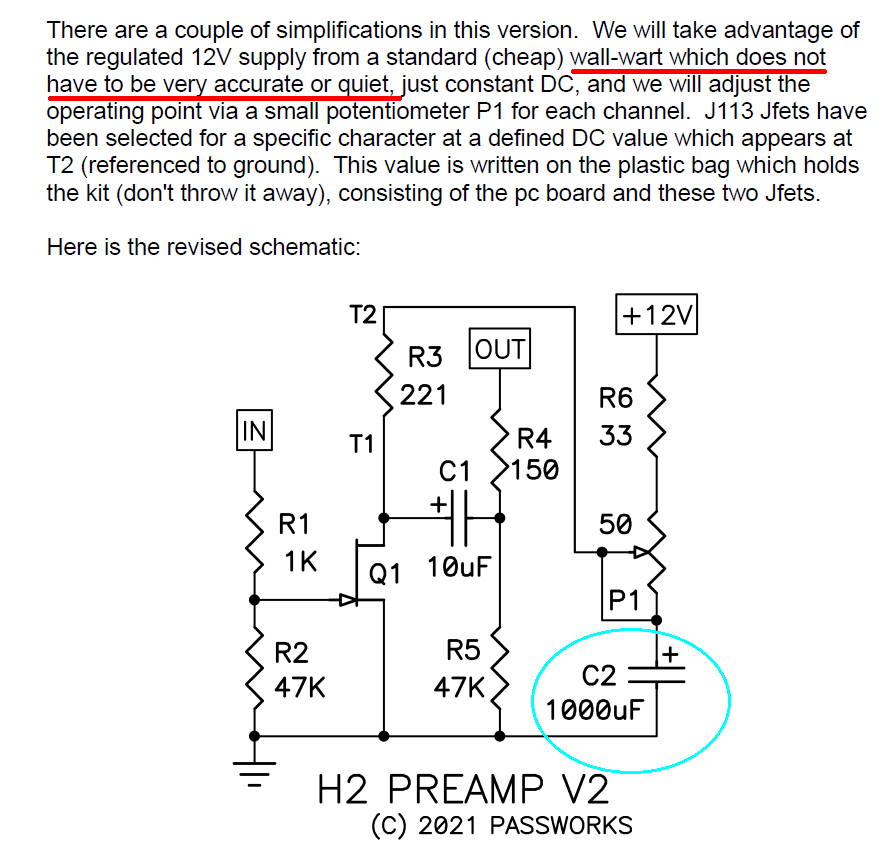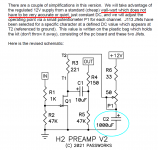Till someone posts a graph to predict distortion level vs voltage, the best we can do is to set T2 voltage lower in steps of say 0.1V and listening to the effect. Keep on doing this until you don't like what you hear anymore and back off a step or two.
And yes, switching the speaker leads is important, and easily overlooked.
.
.
And yes, switching the speaker leads is important, and easily overlooked.
.
.
...... It doesn’t match the beauty of what my B1K does to the music but it wasn’t meant to, was it?
Thanks Nelson.
Pete
But then again, there is a huge difference in cost between the H2 and B1K. I'll settle for a solid improvement for H2 money. BTW, my H2 board is done but I need to put in a chassis.
Question: would the H2 be of any use when combined with a Class D integrated amplifier?
I'm thinking of using it with an Allo Volt+ with stepped attenuator (link below).
And I also need some sort of EQ control to add to the setup (bass, mid, treble), any DIY suggestions for that?

VOLT+ With Stepped Attenuator
I'm thinking of using it with an Allo Volt+ with stepped attenuator (link below).
And I also need some sort of EQ control to add to the setup (bass, mid, treble), any DIY suggestions for that?

VOLT+ With Stepped Attenuator
The usefulness of the H2 does not depend on the amp Class. The nextstep (excuse the pun) would be to build and test it in your system.
Although - I see it is an integrated amp. Not sure if you can even use it here
Although - I see it is an integrated amp. Not sure if you can even use it here

Last edited:
I guess we'll only know for sure once I've built and tested it 🙂
A Class-A amplifier build is on the cards for 2022, it will most likely be used in that setup.
A Class-A amplifier build is on the cards for 2022, it will most likely be used in that setup.
Distortion Measurement
There is a wonderful thread using free software and $30 sound card.
Howto - Distortion Measurements with REW
Till someone posts a graph to predict distortion level vs voltage, the best we can do is to set T2 voltage lower in steps of say 0.1V and listening to the effect. Keep on doing this until you don't like what you hear anymore and back off a step or two.
And yes, switching the speaker leads is important, and easily overlooked.
.
.
There is a wonderful thread using free software and $30 sound card.
Howto - Distortion Measurements with REW
I guess we'll only know for sure once I've built and tested it 🙂
A Class-A amplifier build is on the cards for 2022, it will most likely be used in that setup.
I think your class D integrated amplifier idea is great, add your stepped attenuator, input selector and an SMPS power supply with the DIY filter and you have a great setup.
You could also build the H2V2 with unity gain and use with your favorite preamp.
Being so affordable encourages experimentation, the physical size of the H2V2 makes it even easier.
I think your class D integrated amplifier idea is great, add your stepped attenuator, input selector and an SMPS power supply with the DIY filter and you have a great setup.
You could also build the H2V2 with unity gain and use with your favorite preamp.
Being so affordable encourages experimentation, the physical size of the H2V2 makes it even easier.
Or you could do like i will when i have mine. Make a line preamp with the H2 as gain circuit. I'll add a buffer stage (probally with an NE5532 opamp to use it with different amps with different imput impendances) and an input selector and volume pot. The pre should be able to drive 2 amps, the ACA (or better, 2 aca's set in bridge mode) will be one of them, the other a PP tube amplifier so i need 2x line out (hence the need for a buffer stage).
But first that batch of H2's need to pass the EU customs without issue and get here, which seems to be a problem at the moment...
There is a wonderful thread using free software and $30 sound card.
Howto - Distortion Measurements with REW
Thanks for the heads-up elwood625. That is very interesting.
.
.
Having listened to the new H2 for a few days with T2 voltage set to the value that NP wrote on the plastic bag - which happens to represent 1% distortion, I set the voltage 0.1V lower last night. The sound is still quite enjoyable, with slightly, but noticeably more distortion. But... I prefer the way it was before the drop in voltage. I'll be setting it back to 1% again be done with experimenting.


The H2V2 combined with Wayne’s BA2018 is really wonderful sounding. The BA2018, by itself, is a really beautiful preamp/linestage and sounds like it has some 2nd harmonics to it but the H2V2 is additive.
Hello,
Maybe it is just me but I found the sound coming from the H2V2 more engaging when Mark's smps filter is inserted before the H2V2. Nice combo when used with my BA2018 linestage and DCG3 preamps. Godspeed.
Maybe it is just me but I found the sound coming from the H2V2 more engaging when Mark's smps filter is inserted before the H2V2. Nice combo when used with my BA2018 linestage and DCG3 preamps. Godspeed.
Good on ya @docjrev for trying the experiment!
Your results are a little surprising since (a) the designer didn't think it would matter; and also (b) there's a great big capacitor on the board, which provides a lot of supply filtering (along with 33 ohms + potentiometer resistance).

_
Your results are a little surprising since (a) the designer didn't think it would matter; and also (b) there's a great big capacitor on the board, which provides a lot of supply filtering (along with 33 ohms + potentiometer resistance).
_
Attachments
Hi Mark,
Thanks for the clarification. As I said "maybe it is just me". I have been listening to the H2V2 with and without your filter for about 10 days and for me your filter will not part with my H2V2 generator. Godspeed.
Thanks for the clarification. As I said "maybe it is just me". I have been listening to the H2V2 with and without your filter for about 10 days and for me your filter will not part with my H2V2 generator. Godspeed.
- Home
- Amplifiers
- Pass Labs
- H2 V2 BUILD
